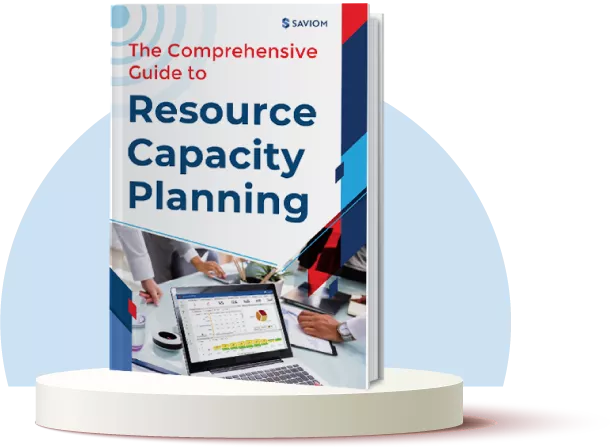The average manager spends 6.61% of the work week creating schedules. And this is if it’s done on spreadsheets. Any guesses on the number when it’s done on pen and paper?
Statistics like these make it clear that manual scheduling won’t work out in your favor, especially as your talent pool expands. This is the reason businesses rely on an employee scheduling software.
A work scheduling software is beneficial to both you and your employees. It frees you up to lead, and manage teams. It also enables you to level resources strategically so that no project suffers from skill crunches, last-minute schedule shifts and sudden unavailability.
Let’s take a closer look at the challenges resource managers around the world presently face and the benefits you get from buying a schedule planning software!

Workforce scheduling challenges
Essentially, employee scheduling software creates a rhythm for multiple work schedules. It uses rules to automate scheduling processes. The predictability boosts workforce productivity by informing departmental team members of their workload.
When your staff know what to expect, they aren’t caught unaware and can chalk out a plan to get more done. You, in turn, are in the know of their exact availability, which lets you set targets against changes in the influx and composition of the workforce. The challenges include –
Irregular scheduling
In project management, assigning a weighting to priority (low, medium or high) ensures the most complex and time-sensitive tasks are attended to first. But new priorities reorder tasks and change existing schedules which, in turn,displaces the resources assigned.
The constant switching between tasks causes your employees to lose track of what they were, and should be doing next. It also adversely impacts your ability to track both task progress and individual performance. The risk here is that you don’t know for certain if everyone is giving work their 100%.
Uncontrolled work hours
Without a staff scheduling software, any imbalances across the schedule that occur are hard to identify and record, much less rectify. Simply put, you won’t know how many workers are being over-utilized or conversely, benched despite being competent and available.
The inability to anticipate workloads results in an uneven distribution of work. When there isn’t enough work to go around, staff are perceived to be slacking off.
Conversely, a surge in work causes hours to get out of hand. And while overtime is an incentive to earn more, it proves to be a productivity detriment in the long run and also preempts stress at work.
Timetable disparities
Disparities between booked and actual hours make it difficult to accommodate demand swings.There’s also the question of billable allocations making use of the right skills. While historic data entries can give insights into previous allocations, you can’t use it to your advantage to forecast the type and people you’ll need for incoming work.
Worse, without a scheduling software for business, you can’t sync timesheets to the project schedule, which compounds your ability to plan the effort bandwidth in times of limited availability and unplanned absences. You’d have to reassign the remaining resources to fill in for work and adjust the budget band against new cost rates.
Benefits of employee scheduling software
Running several business units within an organization requires the right stack of available skills. But considering how labor-intensive it is to create, and alter employee schedules, it makes sense to use a team scheduling software whose algorithms can do the heavy-lifting for you. The benefits of doing so include,
Time-tracking – An analytics facility within a workforce scheduling tool lets you match booked and actual effort hours, ensuring your billing is transparent and yet extracts value out of work. What’s more, you can create rules and automate scheduling for multiple inflight projects.
Skills surety – An employee management software gives unmatched visibility into existing schedules. It sizes up skills, qualification and experience within the existing capacity and lets you tap into potential from within according to fluctuations in resource availability statuses.
Boosts communication – Teams that work cohesively would know task statuses, i.e what is completed and unfinished. They can then get more work off the ground and stay optimally productive. The best employee scheduling program lets you check in on your staff, ensuring you get updates on everything-from milestones reached, progress made to any constraint overruns and flagged concerns.
Trims labor costs – With staffing costs taking up 30% of the spend, being able to forecast demands lets you expand your labor coverage with cost-effective resourcing options, such as part-timers, freelancers or interns. You can then finalize schedule that align with your business needs. An online employee scheduling program lets you control costs by optimizing labor needs for billable utilization.
Work quality compliance – Scheduling software stores contract and certification details and alerts you of expiry dates and skills upgradation programs. Work quality is guaranteed when the right competencies are leveraged at all times, by staff who are prepared for what the project entails.
Evaluate organization’s resources – With a rich source of data that ranges from workforce time and attendance information to skill and performance ratings, you can fill mission-critical roles with competent resources. It also lets you correct skill surpluses and shortages proactively by leveling organizational resources to projects.
Procedural consistency – A consistent scheduling process ensures team members remain productive for the duration of the work that they’re on. Managers too, can rest easy knowing that each task is supplied with an adequate quality and quantity of potential. After all, aligning skills with service-based roles enable your employees to meet client requirements, which leads to higher customer satisfaction levels.
Now that you know the benefits of strategic workforce planning, lets see what you’ll need to consider before getting a total workforce management system.

Choosing the best scheduling software
The first consideration listed in any resource management software’s buyers’ guide is the cost of the tool. After all, it has to have all the right components in order to get its promised benefits that fall in line with business objectives. The selection process has to see to it that the rules and regulations governing data usage are complied with.
Keep the points listed below in mind to narrow down your choices;
Ease of use – What you need is a tool that shortens your learning curve and lets you personalize it according to your business needs. The more configurable the dashboards, sections and modules, the easier it is to understand how it works and where you can find the information you’re looking for.
Integrability – The tool you’re buying should sync with existing systems and plug data across the business into it, ensuring no crucial information is missing. When every business unit is using the system, you have a bird’s eye view of the workflows and can take corrective steps in the event of a mismatch in schedules, leaves and timesheets.
Time-tracking – You can establish timelines with a project timeline template to keep track of all tasks allocated. This lets you build schedules such that high-visibility, high-return projects can stay the course and complete on schedule.
Available technical support – Technical glitches, while inevitable, can occur at any point in time. Besides wasting precious hours, it stalls other tasks in the sequence.. Choose a software with a knowledgeable account manager and reachable support team who can get your system up and running!
Analytics and reporting – Any workforce scheduling software you select should generate reports by turning data into insights. You can then access figures and run through the numbers to take action where necessary. Besides minimizing and even resolving risks, graphical reports let you visualize your business comprehensively.
Inspect these benefits up close with a free demonstration of Saviom’s workforce planning software and experience true scheduling efficiency for yourself!








